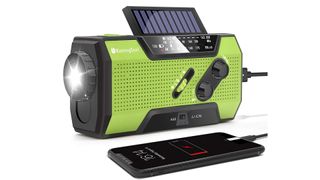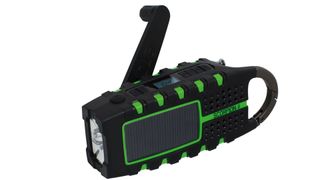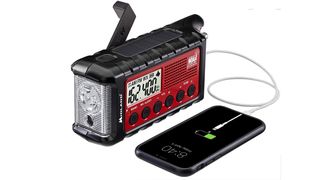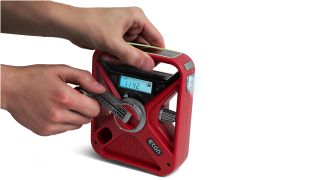The best emergency radios could save your life in the wilderness, so it’s important to be equipped with one at all times if you’re heading away from easy contact with rescue services. They’re not only vital for calling for help, you can use one to receive important information while you’re in the woods, such as weather reports.
These are rugged devices designed to be thrown into backpacks and carried for miles across open country, so they’re frequently water and dustproof, as well as being armored against falls and drops.
Emergency radios are differentiated by the way they’re powered. Some use long-lasting batteries that must be charged or replaced before you leave, while others use a winding mechanism to generate power from rotations of a hand crank. If you’re going to be camped in one place for a long time, also consider one of the best portable generators.
Also look out for features such as phone battery charging and built-in flashlights or sirens. Emergency radios make a great companion with the best personal GPS trackers. And while you’re out in the great outdoors, don’t forget to take one of the best cameras, too.
Best emergency radios 2022
1. Eton Ultimate Camping Radio: Best emergency radio
Why you can trust Top Ten Reviews

The Eton Ultimate Camping Radio is one of the best hand crank radios you can get. It's crammed full of useful features beyond that easy to use crank charging system, which gets you an impressive 10-15 minutes of radio from just four minutes of charging. If you have access to sunlight, the solar panel will fully charge the radio in five hours.
The radio offers AM and FM bands with great sound quality that's both clear and balanced, even when in more remote locations outside of cellular coverage. It also picks up seven NOAA weather stations and SAME alerts. This is built to a high standard with IPX4 water and knock resistance and comes with a full year's warranty. It packs in a powerful LED flashlight which doubles as a morse code beacon, USB port for charging other devices like a smartphone, and even has Bluetooth so you can use it as a 90.3 dB speaker for your connected phone. That loudness is useful as this can also act as a siren.
This packs in a battery that's good for 15.5 hours on a charge and can be charged by – deep breath – hand crank, solar panels and car, mains or mobile battery USB. This great balance of performance, features and price make the Eton Ultimate Camping our pick for the best emergency radio you can buy.
2. RunningSnail MD-090: Best value emergency radio

The RunningSnail MD-090 hand crank radio is a great option if you want an emergency radio without spending a whole bunch. This gets you that hand crank power but also features solar and can charge using micro USB – plus it'll run off disposable batteries. That all comes in an IPX3 water resistant body that's compact but crams in a flashlight as well as a siren and morse code beacon.
Yup, this is one feature rich radio for the price. But that's because of a few downsides. Sound quality isn't great, battery life tops out at 11.5 hours and finding some AM and FM stations was difficult. This is a great emergency radio, just not one we'd recommend for pleasure listening. With five and a half minutes of radio from two minutes of cranking this isn't a bad offering at all. For the price, the RunningSnail MD-090 hand crank radio is a very good budget choice.
3. Eton Scorpion II: Most durable emergency radio

The Eton Scorpion II is one of the most durable emergency radio options out there bar none. Its compact, rubber exterior has an IPX4 water-resistance rating, which means it's good for heavy rain, accidental drops in a river or lake, and any extreme outdoor conditions. It also has a carabiner handle that you can use to securely attach it to the outside of your backpack.
The hand crank can produce nine minutes of battery life during the two minutes of spinning and should only take four hours to fully recharge a dead battery when plugged it into a wall socket. You've also got solar as a charging option too. That's then good for 12.5 hours at maximum volume.
Reception is great across the AM, FM and NOAA bands. But you also get a 3.5mm audio input, so you can plug in and play music from your phone or music player if you don’t want to listen to the radio. This thing even has a bottle opener.
4. Midland ER310 Emergency Crank Radio

The Midland ER310 emergency radio is an affordable dual-power device. With both a hand crank for manual power and a solar pad for green-friendly daylight charging, it’s a reliable device to keep on hand outdoors.
As for the radio itself, the Midland ER310 can pick up both AM and FM frequencies as well as NOAA warnings. Unfortunately, this budget-friendly emergency radio does completely miss out on GPS features.
Thankfully, the radio does pick up the slack in other areas. There's a bright, ultrasonic 1400 Lux LED flashlight, an ultrasonic dog whistle for emergencies and a USB-A port to charge another device. For as low as $60, Midland’s offering is a tremendous option for those just starting out.
- Read our full Midland ER310 review.
5. Esky ES-CR01: Most compact emergency radio

The Esky ES-CR01 certainly is a compact and durable emergency radio and its hand crank is plenty efficient. Beyond that crank option you can charge the internal battery three more ways: using the solar panel, an AC wall plug or a car charger. Unfortunately, unlike some other crank radios this one can’t run on disposable batteries.
A two minute crank should get you four minutes of radio - not the best in our tests by a long way. Plug it into the wall and you're looking at a 14 hour wait to get to full charge. Despite these gripes, this is a super affordable option and still delivers AM, FM, NOAA bands as well as an LED flashlight and IPX3 water resistance.
6. Kaito Voyager Pro KA600: Best for environmental info

The Kaito Voyager Pro KA600 is a premium example of an emergency radio both in price and quality. While you get all the features of the others on this list you can also enjoy extra environmental sensors including a digital thermometer, and a humidity meter. The temperature and barometric pressure alerts you to incoming storms if you are stuck somewhere with poor radio reception and can’t get NOAA or SAME alerts – which this also offers alongside the AM and FM bands.
The KA600's battery gets to full charge in just one hour and 45 minutes, making it the fastest-charging radio we reviewed. However, the battery only lasted one and a half hours when we played it at full volume. Thankfully, this also runs on disposable batteries, so you can use the rechargeable battery as a secondary power source.
This emergency radio also charges with its AC adapter, built-in rechargeable battery pack, USB port or solar panel. It's one of the few radios we tested that has an adjustable solar panel for finding the optimal position to capture the sun's energy. This is bulkier than some but with digital tuning, a powerful LED flashlight and great carry handle it's a really compelling option if you can afford it.
Are emergency radios that important?
We talked to Steve Glockenmeier, VP of Preparedness and Health and Safety for the American Red Cross about the role of a crank radio in an emergency preparedness kit. He shared with us the most important features of a crank radio to consider before adding one to your preparedness kit. Those features include battery operation, an efficient hand crank, solar panel and a USB port for charging mobile devices. He also emphasized the need for an emergency radio to receive weather alerts from National Oceanic and Atmospheric Administration (NOAA), which is included with every radio we tested. The Red Cross has a list of expert tips about what to do before, during and after emergencies or disasters.

What should you look for in an emergency radio?
In its most basic form, a crank radio is a simple handheld device that receives AM and FM signals and can be powered by a hand crank. However, the best models are more than that – they are survival tools. You should look for a crank radio that has as many survival features as possible, is built to be durable and comes from a manufacturer with great support.
SAME Alerts
Every crank radio can pick up all seven NOAA weather alert stations. However, each station is geographically dependent, so you can only pick up one at a time, depending on where you are. The stations provide warnings for severe weather like tornados, hurricanes and flash floods, but they cover large enough areas that you can receive an alert for conditions several states away.
As such, you should consider an emergency radio with SAME technology. With SAME, you enter your zip code and the radio alerts you to weather and environmental conditions in your county.
Emergency Preparedness
You should look for a radio with survival features like a flashlight, siren, compass, dog whistle and a mobile device charger. Every tool you have available in a survival situation is important, and these features can help you find your way and get your bearings if you're lost. They also attract attention if you need help and keep you connected to your phone.
Since these radios are designed to help you survive an emergency, they need to be able to withstand rough conditions. The best models are water-resistant and can survive bumps, drops and jostles. Your radio needs to be able to handle the weather, especially while you're camping.
Help & Support
When we evaluate any electronic device, we like to look in to the kinds of help and support the manufacturer offers. After you purchase your radio, it’s important to have access to help if something goes amiss. The manufacturers we tested have a combination of email and phone support, FAQs pages, and user forums.
Where can you buy Emergency radios?
Now you know what the best emergency radios are, you'll need to move onto purchasing one. Fortunately, the options here are fairly obvious with the usual bunch of retailers keen to offer plenty of different emergency radios.
There's the online-only option of Amazon. That's pretty good if you don't need to worry about looking at the device yourself or seeing how heavy it feels in your hand. Amazon offers plenty of different price ranges plus you can filter things down according to power source type and more.
Alternatively, you could head in-store and try Walmart, Best Buy, or Home Depot. Each has a respectable online presence so you can do a little research online and potentially pick up the same day too. In particular, Best Buy has plenty of filters on its search tool so you can really narrow things down to the ideal emergency radio for your needs. Going in-store can be best if you really want to see the emergency radio in person first and want to check that it looks the right kind of device for you. Plus you have the benefit of still being able to browse online before you commit to anything.
Like with any purchase, it's worth doing some price comparisons too and checking you're getting the best deal wherever you go. No one retailer is the standout best choice here as each retailer often has sales and price cuts going on. Don't be afraid to do a little shopping around to find the better offer.

